Travel
Search
CHARLESTON AND SAVANNAH |
|
Harlan Hague
In Europe, where one visits castles, churches and pubs that date from the fifteenth, fourteenth, thirteenth centuries and before, the eighteenth century can almost be referred to as “recent”. But in the United States, the eighteenth century is ancient history. There are few places in the country where one can see impressive living remnants of the nation’s European origins. That makes Charleston and Savannah the more notable. Carolina, later split into North Carolina and South Carolina, was granted by a grateful King Charles II in 1663 to eight supporters of his recent accession to the throne. Spanish claims to the area, which were stronger than those of England, were ignored. The grantees could use the land as they wished, including the establishment of an aristocracy as long as they created no titles that were in use in England. This American nobility was to include landgrave (German) and cassique, from cacique, the title of Indian chieftains in Latin America. The American titled aristocracy was short-lived, though there is still an association of descendents of landgraves and cassiques in South Carolina today. The first settlement in the new colony was founded in 1670 at the mouth of the Ashley River. The walled enclave was named Charles Town in honor of the King, later changed to Charleston. The port flourished by the export of low country rice and indigo and the importation of goods from England. Black slaves, principally living on small rice plantations, soon outnumbered whites in the colony. By the mid-eighteenth century, Charleston was a sophisticated, cosmopolitan, commercial center which enjoyed frequent balls, concerts, and plays attended by members of the planter and shipper aristocrats in their fine carriages. By the mid-twentieth century, most of the structures from Charleston’s golden era remained, but little of its luster. Like other American cities, its core was decayed and neglected. Happily, Charleston had not been so prosperous in the early twentieth century to warrant tearing down the old buildings in favor of modern utilitarian structures. That changed after WWII when economic expansion created new opportunities. It is fortunate that Charlestonians recognized that they were in danger of losing their heritage and saved the old town from the dubious benefits of “redevelopment”. A visit to Charleston is a step back into the late eighteenth and early nineteenth centuries. The Visitor Center is a good place to start. One can book a bus tour, a tour by horse-drawn open carriage, or pick up a pamphlet that describes a walking tour. Opt for the slow-paced carriage ride, during which the young driver gives a good overview of the sights. Follow this up with a stroll, using the walking-tour map.
At the tip of the peninsula, walk in the parklike Battery and on the promenade along the shore. There is a good view of Fort Sumpter from here. On The Battery and adjoining East Bay Street, notice the restored houses and gardens of the rich eighteenth and nineteenth century planters and shippers. Most of the houses are private residences. Take time to read the plaques on the walls of historic houses that tell their stories. There are also descriptions in the walking tour pamphlets. The walking tour is highly recommended. Set aside a good half day, and walk leisurely. Plan to go into one or two historic houses. Some were restored and are maintained by Historic Charleston Foundation, founded in 1947 to rescue important structures. Others are private, but open to the public. We toured the Nathaniel Russell House, a “mansion-house” set in beautiful gardens. Furnished with antiques of the period, the most notable feature of the house is the unsupported free-standing staircase. Another common feature on the old buildings are the earthquake bolts. Charleston suffered two major hurricanes in 1885 and an earthquake in 1886 that is estimated to have been between 7.7 and 8.0 on the Richter scale. Compare that to the devastating l994 Los Angeles earthquake that measured 6.6. During repairs on brick and wooden structures, workmen inserted long iron rods through the walls and tightened them with bolts against the outside surfaces to bring the buildings back into alignment. The large metal disks became such an attraction that some decorative bolts have been incorporated into recent construction. Beware if you plan to visit Charleston: geologists warn that another devastating earthquake could hit the city—within the next 20,000 years. Charlestonians are proud—sort of—of their portrait of
George Washington. It seems that some of the city fathers in post-revolution Charleston
had seen John Trumbull’s painting of Washington at Trenton, and they wanted their own
portrait. Following the President’s 1791 visit to Charleston, they contracted with
Trumbull to paint one for One of Charleston’s major attractions is eating. Now, I admit to enjoy eating, but it is not a principal reason why I travel. I also admit that atmosphere means as much to me as what is served, so I’m not the best commentator on the fine art of dining. We had lunch twice at Tommy Condon’s, an authentic Irish pub, near the City Market. Hyman’s on Meeting Street calls itself the best seafood restaurant in South Carolina, but I can’t vouch for that because I never got in. I refuse to wait more than twenty minutes to be seated at a restaurant when the down time can be spent more profitably. Just down the street, we liked the fare and informal atmosphere at Sticky Fingers. Just a little further on Meeting Street, we enjoyed the southern cooking at Jestine’s Kitchen, a small unpretentious restaurant named for Jestine Matthews, daughter of a slave father, who cooked for the family of the restaurant’s owner. Jestine died in 1997 at the age of 112. We liked the informal outside dining at Bubba Gump Shrimp Company seafood restaurant on Market Street. Outside Charleston, we visited three plantations. Boone Hall, a few
miles northeast of the city off Highway 17, is a remnant of a plantation. The house is
attractively furnished Northwest of the city, we visited Magnolia Plantation and Gardens and
nearby Drayton Hall. There have been a number of Magnolia plantation houses. The first,
built in the 1680s, burned during the revolution. The second was torched by General
Sherman. It seems that the lower floor survived, and an eighteenth-century house in nearby
Summerville was broken down and reassembled atop the remains. Additions were made later to
result in the present building. In spite of its checkered origins, the property is listed
on the National Register of Historic Places. The gardens are extensive and must be
spectacular when the azaleas are in bloom. I had planned our trip to coincide with the
spring bloom—I thought—but we missed it by a week or two. A restored cabin near
the Like many privately-owned historic properties in every country, Magnolia Plantation has become a bit of a theme park. One can visit the gift shop, browse in the art gallery—framing while you wait—take the kids to the petting zoo, ride the narrated “Nature Train,” schedule weddings and parties, and buy lunch at the snack shop. Perhaps economic necessity requires all this. Nearby Drayton Hall is a jewel. Dating from 1738, Drayton Hall is the oldest plantation house in the United States open to the public and one of the best examples in the country of Georgian-Palladian architecture. It is as it was, in almost original condition, a perfect time capsule. No running water, no electricity, no central heating. It is unfurnished, so the viewer concentrates on the building, not on its contents. With only a little imagination, one can conjure up the lives of the people who lived and worked here for over two centuries. It is wonderful. It is a property of the National Trust for Historic Preservation. There are few distractions from the Hall. The only surviving outbuilding is a brick privy. Hidden from view in a wood are the parking lot, a museum shop housed in a historic nineteenth-century caretaker’s house, and toilets. After the guided tour of the house, have a look at the property on walks along the Ashley River and around the marsh.
Now to Savannah. Not really a sister city, Savannah nevertheless is to Georgia what Charleston is to South Carolina. Granted to General James Oglethorpe in 1732, Georgia was a philanthropic experiment to benefit the poor in England’s prisons and a buffer against Spanish claims in the region. Georgia was meant to be a colony of high morals and personal ownership of property, so land grants were small, and slavery and hard liquor were prohibited, all of which would lead to resentment and slow growth.
In addition to the tree-shaded squares, adorned with banks of azaleas, lawns and monuments, The Historic District of Savannah includes many fine old churches, interesting shops and restaurants, and carefully restored houses on streets lined with huge trees. My wife was drawn to the antique-cum-junk shops. In one particularly unique shop, I admit that I was fascinated with a grouping of life-size images of the Blues Brothers. Still following my wife, we arrived at the most interesting shop of collectibles I have seen in years: Blatner’s Antiques. Paul Blatner is a native Savannahian and a fourteenth generation
southerner. When we entered the store, we weaved our way through a narrow path of stuff.
Stuff. I saw no one and Now, if you haven’t read The Book before going to Savannah, you are at a great disadvantage. You will often be told about something that was mentioned in The Book, or a question will come up about an incident from The Book. If you haven’t read The Book, you will have to make a display of your ignorance by asking questions. The Book is Midnight in the Garden of Good and Evil,
written by John Berendt and published in 1994. It is a history, description and exposé of We had read The Book, and we had seen the television movie based on it, and we visited some of locales that figured in the story. We had breakfast at Clary’s Cafe, the first time because of its association with characters in The Book, the second time because we liked it. Blatner’s Antiques is a half-block away. We saw the restored Mercer House which figures in The Book and to a greater extent in the movie. I’ll not tell you the story and ruin it for you. We saw the club where Chablis, the Grand Empress of Savannah, strutted her stuff. Or his stuff. The Lady Chablis is a man, though he—or she?—bristles when anyone calls her—or him—a man. She—or he—is so unique that they could not find anyone to play her—or him—in the movie, so he—or she—played himself. Or Herself. One should visit at least two or three historic homes to understand
what Savannah was. We toured the Green-Meldrim House, where General Sherman made his
headquarters after he had spared Savannah from the torch. He Savannahians are proud of The Telfair Museum of Art, the oldest art museum in the South. Housed in a distinctive nineteenth-century home, the museum displays paintings, photographs and sculpture, including some traveling exhibits. When we visited, the works of an American impressionist were on display. I can’t remember his name because his work is forgettable. There were some exquisite American impressionist paintings in the permanent collection. The Bird Girl statue, immortalized on the cover of The Book, is displayed here. On long-term loan, it was removed from the cemetery for safekeeping. We wanted to go inside the Second African Baptist Church, founded in the early nineteenth century, but each time we passed by, either the doors were locked, or a service was in progress. Martin Luther King preached his “I have a dream” sermon here, repeated later in Washington. Almost a century before, General Sherman had read the Emancipation Proclamation to Savannahians, mostly black, on the church steps. We did not neglect to investigate some of Savannah’s notable eateries. We stood in line with locals and tourists alike for lunch at Mrs. Wilkes Dining Room. Dish after dish of southern cooking were brought to the family style table: fried chicken, pot roast, sweet potatoes, black-eyed peas, okra, butter beans, etc., etc., cornbread and biscuits, ice tea and banana pudding, overseen by Mrs. Wilkes herself. I liked Churchill’s Pub, British-owned and operated, authentic atmosphere and good food. See it in The Movie. On River Street, which fronts on the Savannah River, we liked Huey’s. Get a table at the front when the large doors are open to the street. River Street is a good example of the success and failure of
preservation in Savannah. Interesting shops, restaurants and pubs are housed in former
cotton warehouses. At one end of the street, we sat for a picnic lunch in the small shady
park, watching the ships go by, and saw the statue of the Waving Girl. The statue depicts
Florence Martus, A walk down River Street is a look into the past—until the Hyatt Regency Savannah looms into view. The preservationists fought against the siting of the hotel, which has no relation to its historic location, but they lost. Now the monolith rises over River Street, and indeed crosses it. Pedestrians and motorists alike pass through a tunnel to reach the River Street shops beyond. The first floor of the riverside portion of the hotel is an elegant, sterile glass-sided dining room. Three particularly interesting attractions outside Savannah are within a short drive. East of the city, Tybee Island is a playground of windswept white sand beaches. The Tybee Lighthouse, dating from 1773, is the oldest and tallest in Georgia. The view from the top is worth the climb of 178 steps. The museum at adjacent Fort Screven features exhibits and photographs detailing Tybee’s past. Between Tybee Island and Savannah, Fort Pulaski was constructed on Cockspur Island by the United States government in the early nineteenth century, one of a series of forts along the Atlantic seaboard. In 1861, at the outbreak of the Civil War, Confederates seized the fort. Union forces regained the fort the following year after a fierce bombardment. Some Union cannonballs are still lodged in the fort’s walls. The well-maintained site is a unit in the National Park Service. West of Savannah, the Mighty Eighth Air Force Heritage Museum tells about the tragedy and heroism of another war. This wonderful museum is worth the better part of a day. Exhibits, including aircraft, dioramas, photographs and personal narratives, are complemented by movies and narrative displays. Very moving and highly recommended. If you drive between Savannah and Charleston, visit Beaufort. This little town boasts some of the most striking eighteenth and early nineteenth century houses in the Low Country. These were the homes of prosperous Sea Island cotton planters. Drive through the residential district, and visit the pretty waterfront shopping area. Both Savannah and Charleston have excellent visitor’s bureaus, with helpful staff and well stocked with materials. Pick up brochures, and get information on tours by bus and horse-drawn carriages and bus services in the historic districts. The Savannah Visitors Bureau is located at 301 Martin Luther King Jr. Boulevard, Savannah, GA 31401, 912-944-0445. The Savannah History Museum is located in the same building. In Charleston, begin your visit at the Charleston Visitor and Transportation Center, 375 Meeting Street, Charleston, SC 29401, 800-868-8118. The Charleston Museum is across Meeting Street from the visitor’s center. If you want to hobnob with nobility, see if you recognize any names at the web site of the Heirs of Hereditary Landgraves & Cassiques Society of South Carolina. |
|
Caveat and disclaimer: This is a freelance travel article that I published some time ago. Some data, especially prices, links and contact information, may not be current. |
|
|
|
|
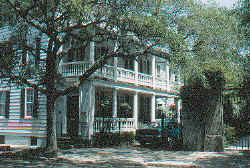 The structure that most
characterizes old town is the unique Charleston Single House. Town lots in the original
walled settlement were narrow and long, requiring the house to be, well, narrow and long.
The Single House is one room wide with a porch running the length of the house. The porch,
which faces either south or west to catch the prevailing breeze, has a door on the street
side. This gives some privacy to residents on the porch. The Single House style can be
found in all sorts of residences, from four-story mansions with handsome gardens to simple
one-level houses. For the best examples of Single Houses, stroll Tradd and Church Streets.
The structure that most
characterizes old town is the unique Charleston Single House. Town lots in the original
walled settlement were narrow and long, requiring the house to be, well, narrow and long.
The Single House is one room wide with a porch running the length of the house. The porch,
which faces either south or west to catch the prevailing breeze, has a door on the street
side. This gives some privacy to residents on the porch. The Single House style can be
found in all sorts of residences, from four-story mansions with handsome gardens to simple
one-level houses. For the best examples of Single Houses, stroll Tradd and Church Streets.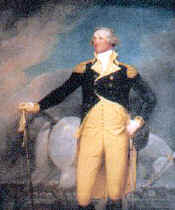 them. He did so, but the city did not like it. It was a heroic painting, but there was
nothing of Charleston in it. They rejected the painting and said that he would have to
paint another to earn his fee. Trumbell did and presented it to them. They were pleased
and paid him the contract price. He said that he had to touch it up a bit and took it
away. When he returned it, he had painted in Washington’s horse behind him, facing
away, his rump prominently displayed. The horse’s tail is raised, ready to dump on
Charleston City Hall between his legs in the background. The painting is displayed in the
Council Chamber of the historic City Hall.
them. He did so, but the city did not like it. It was a heroic painting, but there was
nothing of Charleston in it. They rejected the painting and said that he would have to
paint another to earn his fee. Trumbell did and presented it to them. They were pleased
and paid him the contract price. He said that he had to touch it up a bit and took it
away. When he returned it, he had painted in Washington’s horse behind him, facing
away, his rump prominently displayed. The horse’s tail is raised, ready to dump on
Charleston City Hall between his legs in the background. The painting is displayed in the
Council Chamber of the historic City Hall. 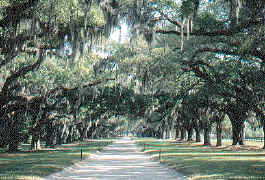 with antiques, but it is not an historic building. The Georgian-style
structure dates from 1935. The arrow-straight drive from the gate to the house, bordered
with huge oaks draped with Spanish-moss, is striking. Nine slave cabins, all listed on the
National Register of Historic Places, are under restoration. The formal gardens are
pretty, but not remarkable. Boone Hall is worth a visit if you are in the neighborhood,
but probably not worth a detour.
with antiques, but it is not an historic building. The Georgian-style
structure dates from 1935. The arrow-straight drive from the gate to the house, bordered
with huge oaks draped with Spanish-moss, is striking. Nine slave cabins, all listed on the
National Register of Historic Places, are under restoration. The formal gardens are
pretty, but not remarkable. Boone Hall is worth a visit if you are in the neighborhood,
but probably not worth a detour.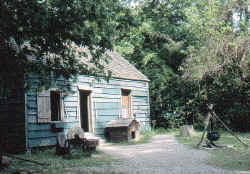 parking lot would have
housed slaves that worked in the plantation house. The furnishings suggest a comfortable
rustic idyll. The plantation booklet notes that “if one had to be a slave, then life
on Magnolia Plantation was relatively enviable.”
parking lot would have
housed slaves that worked in the plantation house. The furnishings suggest a comfortable
rustic idyll. The plantation booklet notes that “if one had to be a slave, then life
on Magnolia Plantation was relatively enviable.”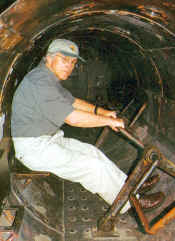 Another worthwhile excursion
from Charleston proper is the Warren Lasch Conservation Center on the old naval base in
North Charleston. The Center is working on preserving the Hunley, the Confederate
submarine that was raised from the bottom of Charleston harbor in August 2000. The Hunley
sank the U.S.S. Housatonic in 1864, becoming the first modern submarine to sink a
major ship. A life-size model of the submarine from the TNT movie, The Hunley,
Another worthwhile excursion
from Charleston proper is the Warren Lasch Conservation Center on the old naval base in
North Charleston. The Center is working on preserving the Hunley, the Confederate
submarine that was raised from the bottom of Charleston harbor in August 2000. The Hunley
sank the U.S.S. Housatonic in 1864, becoming the first modern submarine to sink a
major ship. A life-size model of the submarine from the TNT movie, The Hunley,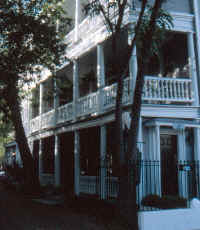 In Charleston we stayed at the
In Charleston we stayed at the
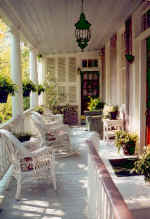 We
paid $99 for a large fourth-floor room which shared a bath with one other room. Rooms on
lower floors with private facilities are higher. A generous uncooked buffet breakfast is
included. Tea, coffee, cookies and fruit are available throughout the day in the light,
airy breakfast room. A sitting room on the second floor is available to guests. Sitting on
the second-story porch in the evening with a glass of wine is most satisfying. Terry and
Debra and housekeeper Debbie are happy to talk about Charleston and
Charlestonians. Be
gentle with Victoria, the timid little wandering black cat that Terry has befriended and
almost can pet. We liked the inn so much that we returned after leaving Savannah.
We
paid $99 for a large fourth-floor room which shared a bath with one other room. Rooms on
lower floors with private facilities are higher. A generous uncooked buffet breakfast is
included. Tea, coffee, cookies and fruit are available throughout the day in the light,
airy breakfast room. A sitting room on the second floor is available to guests. Sitting on
the second-story porch in the evening with a glass of wine is most satisfying. Terry and
Debra and housekeeper Debbie are happy to talk about Charleston and
Charlestonians. Be
gentle with Victoria, the timid little wandering black cat that Terry has befriended and
almost can pet. We liked the inn so much that we returned after leaving Savannah.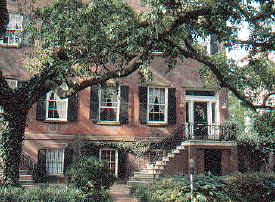 Savannah, founded in 1733, was the first settlement in the new colony. It
became the first planned town in what became the United States.
Savannahians--not Savannahites, we were emphatically told on our first day—are very glad of that
foresight. The old town was laid out around twenty-four squares. The tree-shaded squares
with their gardens and walkways are magnets to tourists and residents alike. And film
producers. Who can forget Forrest Gump sitting on the bench in Chippewa Square? Among
films with Savannah scenes are “Glory,” “Forces of Nature,” “The
General’s Daughter,” and “The Legend of Baggar Vance”.
Savannah, founded in 1733, was the first settlement in the new colony. It
became the first planned town in what became the United States.
Savannahians--not Savannahites, we were emphatically told on our first day—are very glad of that
foresight. The old town was laid out around twenty-four squares. The tree-shaded squares
with their gardens and walkways are magnets to tourists and residents alike. And film
producers. Who can forget Forrest Gump sitting on the bench in Chippewa Square? Among
films with Savannah scenes are “Glory,” “Forces of Nature,” “The
General’s Daughter,” and “The Legend of Baggar Vance”.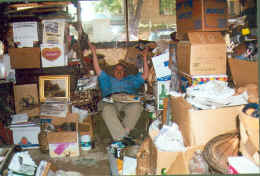 called, “Hello”. A voice answered, but I could not find the
speaker. Finally I saw Paul, sitting in—not on—a stuffed chair, surrounded by
more stuff, stacked almost to the high ceiling. He remained in his chair throughout our
visit. He didn’t have to move. He knew what was in his shop, and he knew where it
was. He quoted prices, and he told us who was interested in this piece and that piece. He
told us what he had sold recently. We were impressed. Paul is a bit of a character and a
curiosity. He has credentials that most Savannahians drool over. He has connections to The
Book.
called, “Hello”. A voice answered, but I could not find the
speaker. Finally I saw Paul, sitting in—not on—a stuffed chair, surrounded by
more stuff, stacked almost to the high ceiling. He remained in his chair throughout our
visit. He didn’t have to move. He knew what was in his shop, and he knew where it
was. He quoted prices, and he told us who was interested in this piece and that piece. He
told us what he had sold recently. We were impressed. Paul is a bit of a character and a
curiosity. He has credentials that most Savannahians drool over. He has connections to The
Book.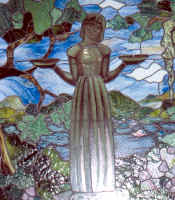 Savannah. It is an account of the resurrection of
historic Savannah after the 1950s, but it also reveals the seamier life of
Savannah. It is an account of the resurrection of
historic Savannah after the 1950s, but it also reveals the seamier life of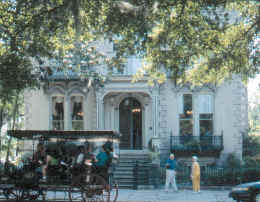 melodramatically presented the city as a
gift to President Lincoln. This fine example of Gothic Revival architecture is the parish
house of nearby St. John’s Episcopal Church. We toured the Owens-Thomas House,
reputedly the best example of English Regency style in the U.S. Built in 1816-1819, it
still contains some original furnishings of the Thomas family. Just across the formal
garden in front of the house, we visited the Owens-Thomas House Urban Slave Quarters. This
unique structure displays items that were made and used by slaves. A narrator told about
the lives of slaves who lived and worked in the city.
melodramatically presented the city as a
gift to President Lincoln. This fine example of Gothic Revival architecture is the parish
house of nearby St. John’s Episcopal Church. We toured the Owens-Thomas House,
reputedly the best example of English Regency style in the U.S. Built in 1816-1819, it
still contains some original furnishings of the Thomas family. Just across the formal
garden in front of the house, we visited the Owens-Thomas House Urban Slave Quarters. This
unique structure displays items that were made and used by slaves. A narrator told about
the lives of slaves who lived and worked in the city.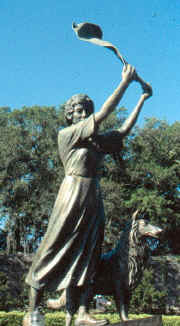 1869-1943, who for forty-six
years waved to ships coming into Savannah Harbor. When the captain of the ship carrying
the statue to Savannah learned the identification of his cargo, he refused to accept pay
for the passage. He remembered with fondness Florence’s faithful welcomes.
1869-1943, who for forty-six
years waved to ships coming into Savannah Harbor. When the captain of the ship carrying
the statue to Savannah learned the identification of his cargo, he refused to accept pay
for the passage. He remembered with fondness Florence’s faithful welcomes.